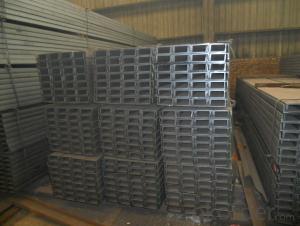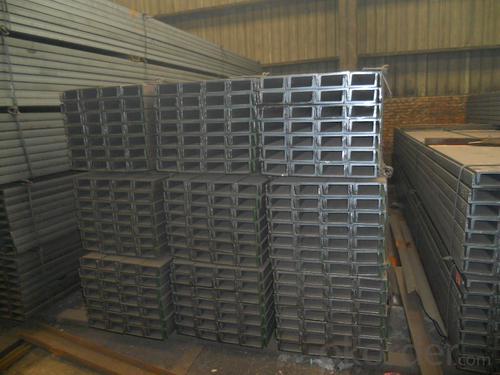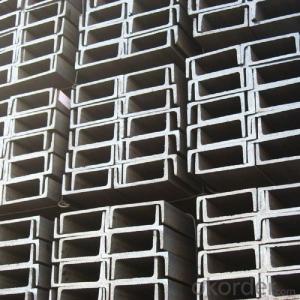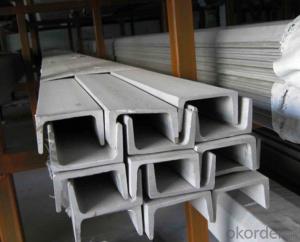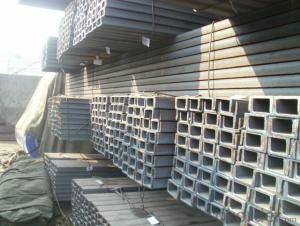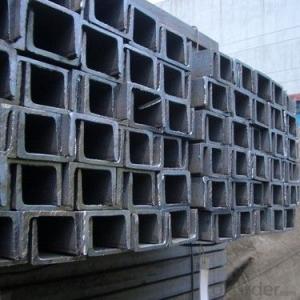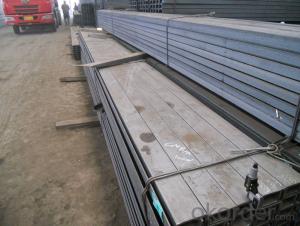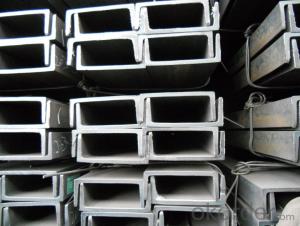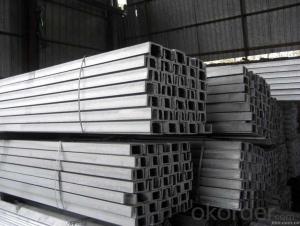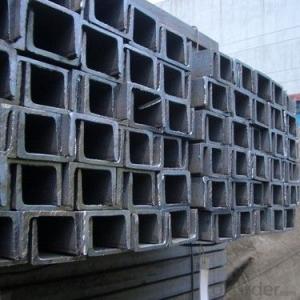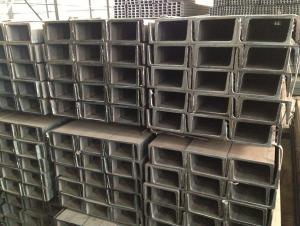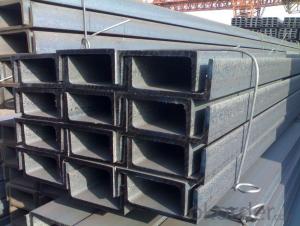JIS SS400 Steel Channel with High Quality 75mm
- Loading Port:
- Tianjin
- Payment Terms:
- TT OR LC
- Min Order Qty:
- 25 m.t
- Supply Capability:
- 10000 m.t/month
OKorder Service Pledge
OKorder Financial Service
You Might Also Like
JIS SS400 Steel Channel with High Quality 75mm
Product Description:
Standard: JIS
Material: SS400
Length: 6m, 12m
Size:
Size (mm) | Mass (Kg/m) |
75*40*4.0 | 5.60 |
| 75*40*4.5 | 5.85 |
75*40*5.0 | 6.92 |
Package & Delivery of JIS SS400 Steel Channel with High Quality 75mm:
1.The hot rolled channel steel will be packed in bundle with steel wire at each end of every bundle and color marking in order to help the customer to recognize his goods more easily at sight.
2. And the hot rolled channel steel could be loaded into 20ft or 40ft container, or by bulk cargo.If the weight of each bundle reaches more than 3.5 mt, the loading by break bulk cargo should be choosed.When the weight of each bundle reaches less than 3mt, the loading by container should be choosed.
3.As for the transportaion from mill to loading port, the truck will be usually used. And the maximum quantity for each truck is 40mt.
4.All in all, we could do in accordance with customer's request.
Production Flow of JIS SS400 Steel Channel with High Quality 75mm:
1.The steel billet shall be heated in the high temperature furnace.
2. The heated steel billet shall be rolled five to nine times with the aim of shaping the general figure of steel u channel.
3. The rolled steel channel should be put onto the cooling bed to make the temperature low.
4. The JIS Channel should be straighted on the straightener.
5. The straighted steel u channel will be cut into meters by saw, as per customer's requirements.
6. At the last part of production, the channel steel must be tested in order to confirm that the finished products are completely free from crack, pore, slag, scab or fold on the surface.
FAQ:
Q1: Why buy Materials & Equipment from OKorder.com?
A1: All products offered byOKorder.com are carefully selected from China's most reliable manufacturing enterprises. Through its ISO certifications, OKorder.com adheres to the highest standards and a commitment to supply chain safety and customer satisfaction.
Q2: How do we guarantee the quality of our products?
A2: We have established an advanced quality management system which conducts strict quality tests at every step, from raw materials to the final product. At the same time, we provide extensive follow-up service assurances as required.
Q3: How soon can we receive the product after purchase?
A3: Within three days of placing an order, we will arrange production. The shipping date is dependent upon the quatity, how many sizes you want and the plan of production, but is typically 1 month to 2 month days from the beginning of production.
Images of JIS SS400 Steel Channel with High Quality 75mm:
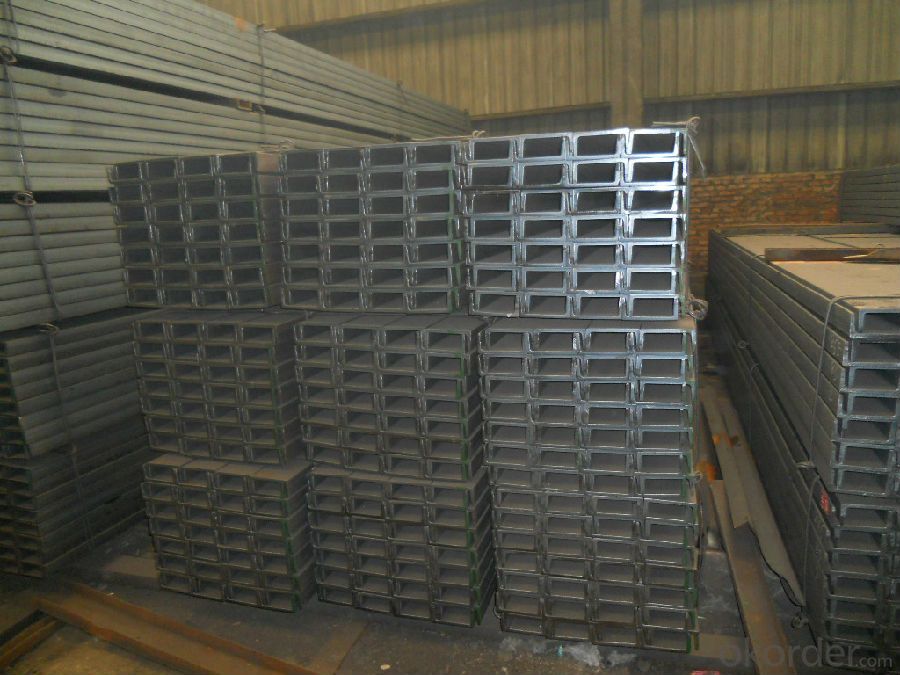
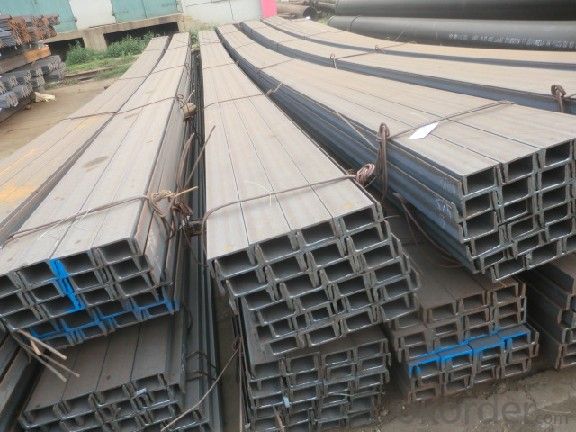
*If you would like to get our price, please inform us the size, standard/material and quantity. Thank you very much for your attention.
- Q: How do steel channels perform under heavy loads?
- Steel channels are known for their exceptional strength and durability, making them highly capable of performing under heavy loads. The structural design of steel channels allows them to distribute and transfer the weight of heavy loads evenly, preventing any concentrated stress points that could cause failure. Additionally, steel channels have a high load-bearing capacity due to their ability to resist bending and twisting forces. This makes them ideal for supporting heavy machinery, equipment, or structures, ensuring stability and safety. Moreover, steel channels can withstand substantial compression and tension forces, making them suitable for a wide range of applications in various industries. Overall, steel channels excel in handling heavy loads by providing reliable support, stability, and load-bearing capabilities.
- Q: How do steel channels contribute to the overall flexibility of a structure?
- Steel channels contribute to the overall flexibility of a structure in several ways. Firstly, they provide additional support and reinforcement to the structure, allowing for the distribution of loads and forces more efficiently. This helps to prevent excessive deflections and deformations, thereby improving the overall stability of the structure. Furthermore, steel channels are highly versatile and can be easily customized and adjusted to fit the specific requirements of a project. Their open shape allows for the insertion of other structural elements, such as beams or columns, which can further enhance the flexibility of the structure. This adaptability enables engineers to design structures with varying span lengths and load capacities, making them suitable for a wide range of applications. Moreover, steel channels offer a high strength-to-weight ratio, meaning they can withstand significant loads while still being relatively lightweight. This characteristic allows for the construction of more flexible and cost-effective structures, as the weight of the channels does not excessively contribute to the overall load on the structure. Additionally, steel channels can be easily interconnected and joined together using bolts, welding, or other methods. This facilitates the construction process and allows for the incorporation of different design elements, such as cantilevers or bracing systems, which can further enhance the flexibility and overall performance of the structure. Overall, steel channels play a crucial role in enhancing the flexibility of structures by providing additional support, adaptability, and strength. Their ability to distribute loads efficiently, accommodate various design requirements, and withstand significant forces make them a valuable component in the construction industry.
- Q: Can steel channels be used in coastal areas?
- Steel channels are indeed suitable for use in coastal areas due to their strength and durability. However, it is crucial to consider the potential impact of saltwater and airborne salt on these channels. The presence of saltwater and salt-laden air can expedite corrosion, especially if the steel channels lack adequate protection. To ensure long-term performance and prevent corrosion damage, it is essential to implement proper protective measures such as corrosion-resistant coatings or galvanization on the steel channels. Regular maintenance and inspections are also highly recommended to promptly address any signs of corrosion or damage. By taking these precautions, steel channels can be effectively utilized in coastal areas and withstand the challenges posed by the marine environment.
- Q: Are steel channels resistant to pests and rodents?
- Steel channels are highly resistant to pests and rodents. Unlike other materials such as wood, steel does not provide a food source or nesting material for pests and rodents. Its smooth surface and hard structure make it difficult for them to chew through or gain access to. Additionally, steel channels are often used in construction and industrial applications where hygiene and cleanliness are important, further deterring pests and rodents. Overall, steel channels provide an effective barrier against infestation and are a reliable choice for preventing pest and rodent issues.
- Q: No. 8 at No. 6 steel, how much is the channel size
- In use, it requires better welding, riveting performance and comprehensive mechanical properties. The raw material steel billet for channel steel is carbon or low alloy steel billets with a carbon content of not more than 0.25%. The finished channel steel is delivered by hot forming, normalizing or hot rolling. The specifications are expressed in millimeters of height (H) * leg width (b) * waist thickness (d), such as 100*48*5.3, which means waist height is 100 mm, leg width is 48 mm, waist thickness is 5.3 mm channel, or 10# channel steel. The same height of the channel, if there are several different leg width and waist thickness, also need to add a, B, C on the right side of the model to distinguish, such as 25#a, 25#b, 25#c and so on.
- Q: What are the different alloy compositions available for steel channels?
- Steel channels are available in various alloy compositions, each with its own unique properties and advantages. Some commonly used alloy compositions include: 1. Carbon Steel: This is the most basic and widely used type of steel. It primarily consists of iron and carbon, along with small amounts of other elements. Carbon steel channels offer good strength and durability, making them suitable for various applications. 2. Stainless Steel: This alloy composition contains iron, chromium, and nickel. Stainless steel channels are highly resistant to corrosion and possess excellent strength and heat resistance. They are commonly used in environments where resistance to rust and staining is crucial, such as in the food industry or marine applications. 3. Alloy Steel: This composition consists of iron, carbon, and other alloying elements like manganese, chromium, or molybdenum. Alloy steel channels offer enhanced strength, hardness, and wear resistance compared to carbon steel. They find applications in industries requiring high tensile strength, such as construction, automotive, or machinery manufacturing. 4. High-Strength Low-Alloy (HSLA) Steel: HSLA steel channels contain small amounts of alloying elements like copper, vanadium, or niobium. These alloys enhance the strength and toughness of the steel while maintaining good weldability and formability. HSLA steel channels are commonly used in structural applications, bridges, or automotive components. 5. Weathering Steel: This composition includes iron, chromium, and copper. Weathering steel channels are designed to develop a protective rust-like coating when exposed to the atmosphere. This coating acts as a barrier against further corrosion and eliminates the need for painting. Weathering steel channels are often used in outdoor structures like bridges or building facades. Choosing the appropriate alloy composition for steel channels is crucial and depends on specific application requirements, considering factors such as strength, corrosion resistance, weldability, and cost. Seeking guidance from a materials engineer or steel supplier can help determine the most suitable alloy composition for steel channels.
- Q: What's the name of channel steel?
- Channel steel is divided into ordinary channel steel and light channel steel.Again: according to different shapes, they can be divided into 4 kinds: cold bending equilateral channels, cold-formed non equilateral channel steel, cold rolled edge channels, the cold bending edge channels.
- Q: Can steel channels be used for load-bearing walls?
- In traditional construction methods, load-bearing walls are not typically constructed using steel channels. Load-bearing walls require materials with high strength and load-carrying capacity in order to support the weight of the structure above them. Although steel channels are commonly used for structural support in framing and bracing applications, they are not typically the primary material for load-bearing walls. This is because steel channels have a limited load-carrying capacity compared to materials like concrete or steel beams. Load-bearing walls are usually constructed using materials such as concrete blocks, bricks, or steel beams, which can handle the significant vertical load imposed by the structure.
- Q: How are steel channels installed in construction projects?
- Construction projects often utilize steel channels for their strength and versatility. To ensure proper alignment and stability, the installation of steel channels involves a series of steps. Firstly, architects, engineers, and construction teams coordinate to determine the location and layout of the steel channels based on project specifications and structural design. This requires meticulous planning. Next, the designated areas for steel channel installation are prepared. This may involve clearing the site, leveling the ground, and providing a stable foundation. Excavation or backfilling may also be necessary. Once the site is ready, the steel channels are delivered to the construction site. These channels are typically pre-fabricated with the required dimensions and specifications. Cranes or other lifting equipment are used to transport them to the installation area. Before installation, the construction team ensures that the steel channels are clean and free from debris or contaminants. This is crucial for proper bonding and stability during the installation process. The installation begins by aligning the steel channels in their designated positions. Laser levels, plumb bobs, or other alignment tools are used to ensure accurate placement. Clamps or braces are temporarily used to secure the channels in place. To permanently fix the steel channels, welding or bolting methods are typically employed. Skilled welders carefully join the channels to other structural elements, ensuring strong and durable connections. If welding is not feasible, bolts or screws may be used for securing the steel channels. Holes are drilled through the channels and corresponding structural elements, and bolts or screws are inserted and tightened to create a secure connection. Throughout the installation process, quality control measures are implemented to ensure correct installation. Inspections, measurements, and testing are conducted to verify alignment, levelness, and structural integrity. Once all the steel channels are installed, they undergo inspection for any defects or imperfections. Adjustments or repairs are made if necessary to meet the required standards and specifications. In summary, the installation of steel channels in construction projects requires careful planning, preparation, alignment, and secure attachment to other structural elements. Following proper installation procedures and implementing quality control measures is crucial for ensuring the channels provide the necessary structural support and stability.
- Q: What are the different bending techniques for steel channels?
- Steel channels can be bent using various techniques, depending on the desired outcome and the equipment at hand. Some popular bending techniques for steel channels are as follows: 1. Roll Bending: By passing the steel channel through a series of rolls, it can gradually be shaped into the desired form. Roll bending can be performed in different ways, such as pyramid rolling, which utilizes three rolls to create a pyramid shape, or double pinch rolling, which employs two rolls for a more uniform bend. 2. Press Bending: Utilizing a press machine, force is applied to the steel channel, resulting in its bending. This technique is often employed for smaller channels or when a tighter radius is required. Press bending can be executed with the aid of a V-die, ensuring a smooth bend, or a bottom bending die for more intricate shapes. 3. Induction Bending: This technique involves heating the steel channel to a specific temperature using an induction coil, making it more pliable. Once heated, a bending machine or a set of rolls is used to bend the channel. Induction bending is commonly used for large or thick steel channels that necessitate precise and consistent bends. 4. Rotary Draw Bending: A mandrel and a set of dies are employed in rotary draw bending to bend the steel channel. The mandrel is inserted into the channel to prevent wrinkling or collapsing during the bending process. This technique is often utilized for tight radius bends or when maintaining the structural integrity of the channel is of utmost importance. 5. Stretch Bending: By clamping the ends of the steel channel and applying force, it can be stretched over a mandrel or a form. Stretch bending is commonly employed for larger channels or when creating long, sweeping curves. Each bending technique offers its own advantages and limitations, and the choice of technique depends on factors such as the desired bend radius, the thickness of the steel channel, and the available equipment. It is crucial to consider the specific requirements of the project and seek guidance from professionals in order to determine the most appropriate bending technique for steel channels.
Send your message to us
JIS SS400 Steel Channel with High Quality 75mm
- Loading Port:
- Tianjin
- Payment Terms:
- TT OR LC
- Min Order Qty:
- 25 m.t
- Supply Capability:
- 10000 m.t/month
OKorder Service Pledge
OKorder Financial Service
Similar products
Hot products
Hot Searches
Related keywords
